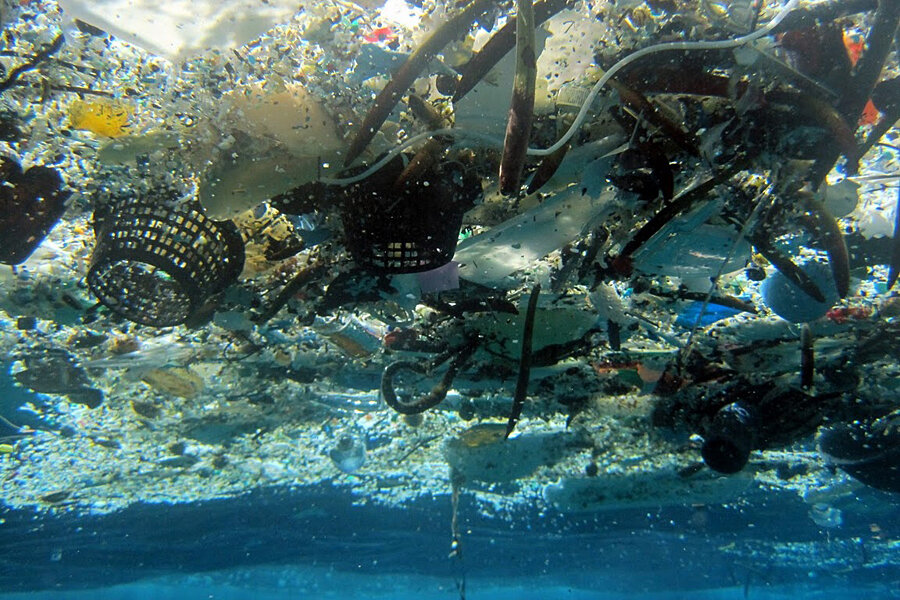Study: 5 trillion-plus pieces of plastic floating in ocean. What can be done?
Loading...
More than 5 trillion pieces of plastic, weighing nearly 269,000 tons, are littering the world's oceans, according to a study published Wednesday by the scientific journal PLOS One. The study is the first of its kind to gather data from around the world on floating plastic.
For the study, researchers traveled the world's seas on 24 expeditions between 2007 and 2013, collecting small pieces of plastic from all five subtropical gyres, or spots in the ocean where currents converge. From there, using computer models, they extrapolated to estimate global numbers.
The researchers gathered data in areas where scientists haven't had measurements for floating plastic debris, including the Indian Ocean, the Southern Ocean near Antarctica, and the South Atlantic, according to Kara Lavender Law of the Sea Education Association in Falmouth, Mass., who wasn't involved in the study.
The study's estimate for plastic bits less than one-fifth of an inch – about 35,540 tons – is comparable to an earlier study by researchers in Spain who used different methodology, Ms. Law said. That study estimated there were 7,000 to 35,000 tons of plastics this size floating in the ocean.
It's encouraging that two different approaches came up with similar answers, given how difficult it is to measure plastic in the ocean, she said.
The largest source of plastic pollutants was found to be discarded fishing nets and buoys. As a possible remedy, lead researcher Marcus Eriksen, co-founder of the nonprofit 5 Gyres Institute, advises creating an international program to pay fishing ships to reclaim nets, according to The New York Times.
Still, that would do little to solve the problem of discarded bags, toys, bottles, and other trash adrift.
"We saw turtles that ate plastic bags and fish that ingested fishing lines," Julia Reisser, one of the researchers based at the University of Western Australia, told The Guardian. "But there are also chemical impacts. When plastic gets into the water, it acts like a magnet for oily pollutants."
While bigger plastic pieces can strangle animals such as seals, smaller pieces can get eaten by fish and then travel up the food chain.
"Plastics are like a cocktail of contaminants floating around in the aquatic habitat," Chelsea Rochman, a marine ecologist at the University of California, Davis, told The New York Times. "These contaminants may be magnifying up the food chain."
Law echoed this sentiment.
"Am I being poisoned by eating the fish on my plate?" she asked, according to The Associated Press. "We have very little knowledge of the chain of events that could lead to that. But it’s a plausible scenario that plastic ingested at lower levels of the food web could have consequences at higher levels of the food chain."
Researchers say the volume of plastic debris is likely to grow due to increasing production and because 5 percent of the world's plastic gets recycled.
"Lots of things are used once and then not recycled," Ms. Reisser said. "We need to improve our use of plastic and also monitor plastics in the oceans so we get a better understanding of the issue."
One fashionable solution for clearing plastics from the oceans can be found at Bionic Yarn, a New York City-based start-up that makes clothes from recycled ocean plastic. The business has partnered with the designer clothing company G-Star RAW and singer Pharrell Williams.
As for other actions individuals can take to reduce plastic waste in the oceans, the 5 Gyres Institute recommends a deeper look at the products individuals buy to see whether they contain plastic and what happens to them once they're thrown out.
"Know the lifecycle of what you buy – what happens to your products when you're through with them? Shift some habits as you go along – commit to put your bags in the car, to not use plastic bottles, etc.," reads a statement on the 5 Gyres website. "Support legislative efforts to manage waste in your local community – your voice must be heard!"
• Material from The Associated Press was used in this report.








